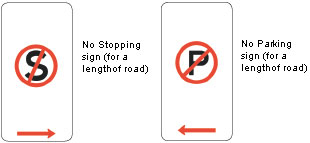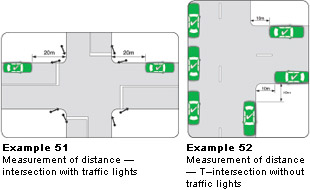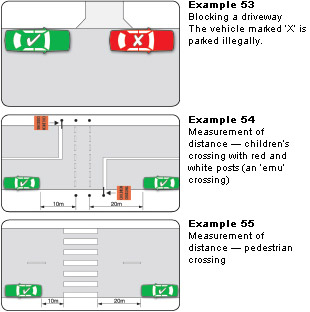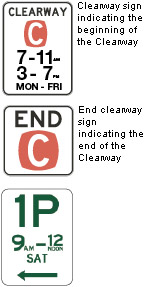The Driver's Handbook
Parking

Parking is when you stop and allow your vehicle to stay in one place, whether or not you leave the vehicle unattended. Parking is allowed in many places on the road and in road-related areas and you should always obey any signs.
At all times when stopping or parking, you must not open the doors of the vehicle so as to endanger bicycle riders, pedestrians or other road users.
Parallel parking
Unless there are signs or markings on the road to indicate some other method, you must park parallel to the edge of the road and footpath. The rules are:
- park your vehicle so that it is facing in the same direction as the moving traffic
- in a two-way road, park your vehicle parallel to and as near as practicable to the left edge of the road
- in a one-way road, park parallel to and as near as practicable to the left or right edge of the road
- where parking bays are marked on the road, leave your vehicle entirely within a single bay, unless the vehicle is too wide or long to fit completely within the bay
- where there are no parking bays, leave at least one metre between your vehicle and the vehicles in front and behind
- Unless permitted by a parking sign, leave a minimum of three metres between your vehicle and any continuous dividing line or dividing strip (Example 48); or, if there is no continuous dividing line or strip, leave a minimum of three metres from the other side of the road.
- if your vehicle is a heavy or long vehicle, it must be parked in the minimum number of parking bays, if there are parking bays available.
Angle parking

Angle parking is indicated by signs or road markings. It means you must park your vehicle at the appropriate angle to the kerb, as indicated by the sign or markings on the road and you must park entirely within a parking bay.
If a sign states angle parking is allowed at an angle other than 90°, the driver must park with the front of the vehicle to the kerb unless a sign indicates otherwise.
If a sign states Angle Parking but does not give the exact angle, you must park at 45° with the front of the vehicle to the kerb (Example 49) unless a sign indicates otherwise.
If a sign or markings indicate 90° parking, you may park with your front or rear to the kerb (Example 50) unless a sign indicates otherwise.
Heavy vehicles
If your vehicle is a heavy or long vehicle:
- it must not obstruct other road users or pedestrians
- it must not be parked on a road in a built-up area for more than one hour unless:
- a sign or traffic control device allows a longer period
- the driver is dropping off or picking up goods and stays for no longer than is necessary to complete the task
- a local council has granted an exemption.
A vehicle is heavy vehicle if it has a gross vehicle mass of 4.5 tonnes or more; and a vehicle is long if, together with any load, projection, caravan or trailer, it is 7.5 metres long or longer.
No Stopping
To 'stop' a vehicle means to stop and remain stationary for even a short period of time. You must not stop or park your vehicle in any area where a 'No Stopping' sign or a continuous yellow edge line applies, even to pick up or set down passengers or goods.
No Parking

You must not park your vehicle in an area where a 'No Parking' sign applies, unless:
- you are dropping off or picking up passengers or goods
- you do not leave the vehicle unattended - that is, move more than three metres away and
- you complete the dropping off or picking up as soon as possible - in any case, within two minutes.
Please note: a No Standing sign has the same meaning as a No Stopping sign.
Where Stopping and Parking are banned


Unless a sign permits you to do otherwise, you must not stop or park your vehicle:
- within 20 metres of an intersection with traffic lights (Example 51)
- within 10 metres of an intersection without traffic lights, except when parking on the continuing road of a T-intersection opposite the terminating road (Example 52)
- on or across a driveway (Example 53 – page 100) or other way of access for vehicles to private land unless you are dropping off or picking up passengers within 2 minutes of stopping and you do not leave the vehicle unattended
- on or across a footpath, or a footpath ramp
- on a pedestrian crossing or within 20 metres before, or 10 metres after a pedestrian crossing (Examples 54 and 55).
- on an area of road on which the words 'Keep Clear' are marked
- within one metre of a fire hydrant, fire hydrant indicator or fire plug indicator
- within 20 metres before and after the nearest rail or track of a railway or tram level crossing (Example 16)
- 20 metres before and 10 metres after a bus stop
- in a bus zone indicated by signs
- next to a vehicle that is parked at the side of a road (double parking)
- in a Loading Zone, unless you are:
- driving a commercial vehicle loading or unloading goods (and then for no longer than 30 minutes or as indicated on the sign)
- driving another sort of vehicle and loading or unloading a cargo that is difficult to handle due to its weight or size (and then for no longer than 30 minutes or as indicated by the sign)
- driving a public bus or taxi (and then only to immediately set down or pick up passengers)
- permitted to park, as indicated by the sign
- on any bridge, tunnel, causeway, ramp or culvert, unless the road is at least as wide on or in the structure as it is on each of the approaches
- on or near a crest or curve outside a built-up area unless you can be seen for at least 100 metres by drivers travelling in the same direction
- in a zoned area, unless your vehicle is of the type allowed, such as a taxi in a taxi zone
- in a lane designated for a particular type of vehicle, such as bus lane or bicycle lane, unless you are driving that sort of vehicle
- on a footpath, dividing strip, or nature strip
- within three metres of a post box unless dropping off, or picking up, passengers or mail
- where a motorcycle or bicycle parking sign applies, unless riding a motorcycle or bicycle respectively
- in a parking area reserved for people with disabilities, unless displaying a valid permit
- on a painted island.
A person driving a vehicle fitted with an alcohol interlock device would have a defence to a parking offence provided they remain with the vehicle and stop for no longer than necessary to comply with the scheme's conditions.
Causing an obstruction or danger

It is an offence to stop or park a vehicle on a road in a position that could:
- cause or be likely to cause danger to other traffic or people
- be likely to obstruct traffic on a road.
Clearways
A Clearway is a length of road indicated by a sign(s) on which stopping and/or parking are restricted during times of peak traffic use. The operating hours are indicated on signs at the start of and in the Clearway. You must not stop on a Clearway, including setting down or picking up passengers, during the operating hours. Buses are exempt.
Time limits
Where there is a time limit indicated by a sign, you must not park in the zone for longer than the specified time limit.
It is an offence to exceed the maximum time limit indicated on the parking sign by placing more coins in a parking meter or ticket dispensing machine.
Australian disability parking scheme

A vehicle displaying an Australian disability parking permit is allowed to park as follows:
- if the time limit on the parking sign is less than 30 minutes they can park for 30 minutes
- if the time limit on the sign is 30 minutes to an hour they can park for two hours
- if the time limit on the sign is more than 1 hour they can park for twice the period of time indicated on the sign
If a fee is payable to park on a street a permit holder is required to pay for the time stated on the parking sign but does not have to pay for the additional time they are permitted to stop.
Please note, the additional time allowance does not apply to parking spaces set aside for people with disabilities.
Parking at night
You can leave your vehicle parked on the road at night without the parking lights on if there is a street light or other lamp alight that is making it clearly visible from a distance of 200 metres. Otherwise, if you leave your vehicle parked on the road at night, it must have front and rear parking lights alight.
If a vehicle is 2.2 metres wide or wider, you must have the clearance and side marker lights alight for the safety of other road users unless there is street lighting making it clearly visible from a distance of at least 200 metres.
General Exemptions to Stopping and Parking rules
The parking rules referred to previously, do not apply under the following circumstances:
- to avoid a collision
- if your vehicle is disabled
- because of the condition of driver or passengers, in the interests of safety
- to deal with a medical emergency
- to obey the directions of a police officer
- to comply with another law.
In each case, you must not park or stop for any longer than is necessary in the circumstances and you should move your vehicle as soon as you can.
These exemptions do not apply to the requirements to:
- have lights on a parked vehicle at night (see Parking at night)
- obey a 'Keep Clear' road marking.
Tow-trucks, emergency vehicles and postal vehicles are exempt when acting in the course of their duties.
Buses are permitted to stop to pick up and drop off passengers, but not on the South-Eastern Freeway and the Southern Expressway.
On the South-Eastern Freeway and the Southern Expressway, you may only stop in the emergency stopping lane and then only in an emergency.































